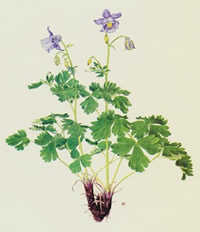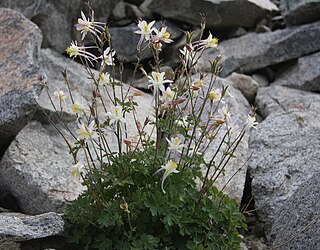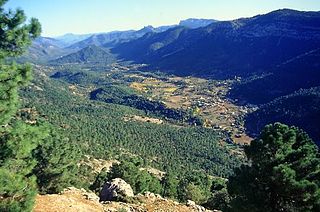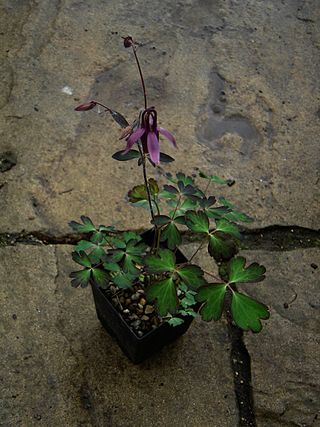
Aquilegia nuragica, commonly called Nuragica columbine, is a perennial flowering plant in the family Ranunculaceae. It is endemic to Italy, in a single canyon in the Supramonte mountain range on the island of Sardinia.

Aquilegia pubescens is a perennial flowering plant in the family Ranunculaceae, endemic to the Sierra Nevada in California. It is usually known by the common name Sierra columbine, and less frequently as the alpine columbine or Coville's columbine.

Sierras de Cazorla, Segura y Las Villas Natural Park is a natural park in the eastern and northeastern part of the province of Jaén, Spain, established in 1986. With an area of 2,099.2 square kilometres (810.5 sq mi), it is the largest protected area in Spain and the second largest in Europe. It was declared a biosphere reserve by UNESCO in 1983 and also a Special Protection Area for migratory birds in 1988.

Paeonia broteri is a perennial, herbaceous species of peony. It is an endemic species of the Iberian Peninsula. It bears rose-pink highly fragrant flowers about 12 cm wide and glossy green leaves. It reaches up to 40 centimetres (16 in) in height.

Aquilegia rockii is a perennial flowering plant in the family Ranunculaceae, native to southern China.
Aquilegia aradanica is a perennial flowering plant in the family Ranunculaceae, endemic to Siberia.
Aquilegia aragonensis is a perennial flowering plant in the family Ranunculaceae, endemic to northern Spain.

Aquilegia barykinae is a perennial flowering plant in the family Ranunculaceae, endemic to the Russian Far East. The species was first described in 2014. Its flowers are lilac-blue.

Aquilegia bashahrica is a perennial flowering plant in the family Ranunculaceae, endemic to the Himalayas.
Aquilegia chitralensis is a perennial flowering plant in the family Ranunculaceae, endemic to Pakistan.
Aquilegia colchica is a perennial flowering plant in the family Ranunculaceae, endemic to the Caucasus mountains in Georgia. The plant blooms in spring with blue and white flowers. It is considered an endangered species in Georgia.
Aquilegia cremnophila is a perennial flowering plant in the family Ranunculaceae, endemic to Sardinia.
Aquilegia cymosa is a perennial flowering plant in the family Ranunculaceae, endemic to Pakistan.

Urophysa henryi is a perennial flowering plant in the family Ranunculaceae, endemic to southern China.
Aquilegia dichroa is a perennial flowering plant in the family Ranunculaceae, native to Portugal and northwestern Spain.

Aquilegia discolor, commonly known as the two-coloured columbine, is a perennial flowering plant in the family Ranunculaceae, endemic to northwestern Spain.

Aquilegia dumeticola is a perennial flowering plant in the family Ranunculaceae, native to southeastern Europe.
Aquilegia grubovii is a perennial flowering plant in the family Ranunculaceae, native to northern Mongolia and Tuva in Russia.
Aquilegia guarensis is a perennial flowering plant in the family Ranunculaceae, native to the Pyrenees.
Aquilegia hebeica is a perennial flowering plant in the family Ranunculaceae, native to northern China.











